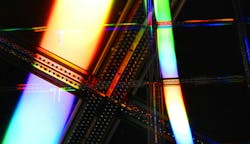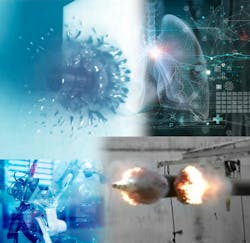Ultrafast cameras get next-gen high-quantum-efficiency, low-noise CMOS image sensors
Developing ultrahigh-speed complementary metal-oxide semiconductor (CMOS) image sensors is challenging for many reasons. At very high frame rates, the time available to capture each image (integration time) is extremely short, which severely limits the quantity of photons that interact with the image sensor during each frame. Consequently, ultrahigh-speed image sensors require very high sensitivity (quantum efficiency) so no photons go to waste.
It is also necessary to capture and remove the generated signal electrons quickly to avoid blurring of the captured image with subsequent frames, a.k.a. lag. Once a signal is detected, it must be processed and transmitted from the image sensor to the camera system. The amount of data recorded by a high-resolution, high-dynamic-range image sensor running at ultrahigh speed can far exceed the bandwidth of hundreds of even the fastest available data interfaces running in parallel, so novel solutions are needed to ensure captured signal data is not lost.
CMOS image sensor design
Detection of weak signals is all about maximizing the signal-to-noise ratio. As well as maximizing the quantum efficiency, it is equally important to minimize noise sources within the sensor so the relatively weak signal provided by the limited available light can be detected above the noise floor. But running the sampler circuits, pre-amplifiers, and analog-to-digital converters within an image sensor at high speeds tends to increase the noise.
The design of these circuits—including individual transistor geometries and layout—must be optimized with regard to speed, noise, and crosstalk. It requires extensive knowledge of the mixed-signal circuit design and fabrication processes used, as well as significant simulation and verification using cutting-edge software design tools.
Drawing upon our team of experienced CMOS specialists, SI Sensors is designing image sensors that approach the limit of what’s physically possible. For ultrafast imaging, we’ve designed novel structures within the photodiode to create drift fields that increase the velocity of the signal electrons to allow them to be swept out of the photodiode and sampled much faster. This significantly improves the temporal resolution of these sensors and enables photon detection and signal-electron transfer to be achieved at nanosecond resolution.
We’re developing several methods to store the detected signal data on the chip, which enables burst-mode imaging to capture more data than is possible to transmit in real time. One method we’re refining is the integration of charge-coupled device (CCD) technology within CMOS image sensors, known as CCD-in-CMOS.
CCDs enable storing signal within the charge domain, prior to both voltage conversion and subsequent digitization. These signal conversions limit the frame rate of conventional image sensors. Traditionally, CCD-in-CMOS was used to mimic the function of CCDs within a CMOS image sensor for applications such a time-delay integration (TDI), but we’re using the CCD storage as analog memory and arrays of CCD storage memories for each pixel within the image sensor. This architecture can enable thousands of frames to be captured at nanosecond temporal resolution with high-dynamic range and stored as signal charge with very low noise.
Once the image capture sequence is complete, the CCD array is read out and sampled in a conventional way at relatively low speed, which again minimizes noise. CMOS pre-amplifiers, analog-to-digital conversion circuits, and high-speed serial interfaces are then used to transmit the high-dynamic-range signal data to the camera system with high integrity.
Using CCD-in-CMOS technology combines the best attributes of both CCD and CMOS sensors. The hybrid technology significantly enhances the capabilities of burst-mode imaging to enable ultrafast capture speed with unprecedented sensitivity and image quality, which makes it ideal for applications that require ultrahigh-speed image capture and analysis.
Key features and benefits
Ultrafast burst-mode is capable of capturing millions of frames per second, which is ideal for observing fast transient events in scientific research, industrial testing, and medical diagnostics.
High sensitivity and low noise provided by CCD-in-CMOS sensors ensure high signal-to-noise ratio and clear and detailed images—even in low-light conditions.
Efficient data handling, enabled by advanced in situ storage and readout mechanisms, reduces system complexity.
Versatile applications, from high-speed video recording to hyperspectral imaging, CCD-in-CMOS technology is adaptable to various imaging needs.
Innovative applications
This technology opens new possibilities in several fields. For scientific research, it enables capturing high-speed phenomena in physics, chemistry, and biology with unparalleled clarity. In industrial testing, it enables monitoring and analyzing fast-moving processing for manufacturing and quality control. For medical diagnostics, it enhances imaging techniques and provides better insights into dynamic biological processes.
Our ability to create ultrafast burst-mode image sensors will revolutionize high-speed imaging. This new generation of CCD-in-CMOS image sensors records at millions of frames per second with full resolution, which provides exceptional capture speed with high signal-to-noise ratio to ensure clear and detailed images of the fastest observable events. It is adaptable to imaging applications ranging from high-speed video recording to hyperspectral imaging and enables efficient data handling through advanced in situ storage, control, and readout mechanisms.
Cameras using these next-gen sensors will allow scientists to image ultrafast phenomena more precisely and with more detail than before, and help speed developments in applications such as nuclear fusion, ballistics, detonics, medical research, spray analysis, combustion research, nanotechnology, and failure dynamics.
About the Author
Phil Brown
Phil Brown is the general manager of SI Sensors in Cambridge, U.K.

